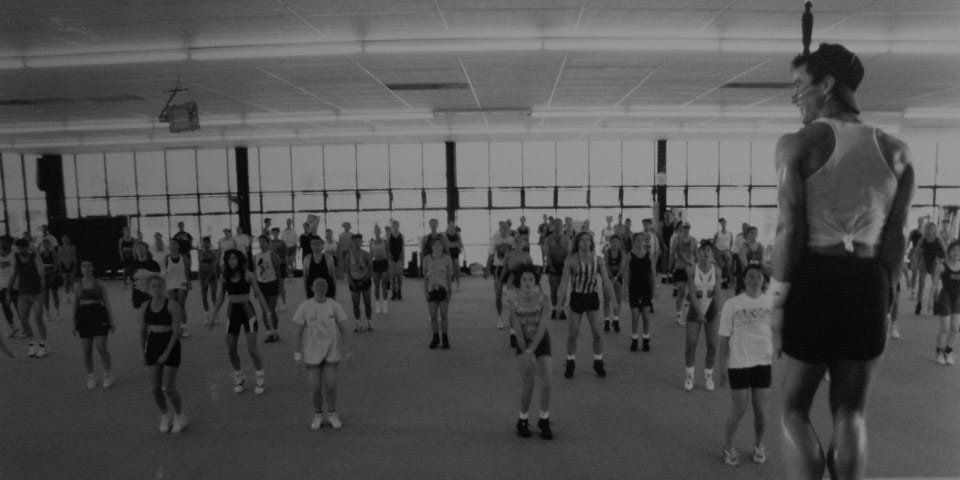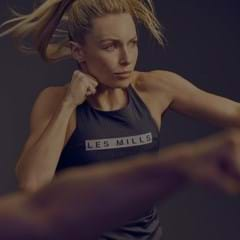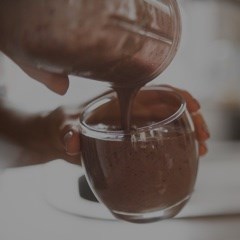SARAH SHORTT: How long does it take you to create a release?
GLEN OSTERGAARD: You can look at the release in three parts: finding the music, creating the choreography, and then finessing the class with final tweaks.
It’s the music that takes the longest, and the music always comes first. For BODYPUMP™, I'll spend two to three weeks going through all the songs I’ve collected and been given over the round and get them down to about 100 tracks. Diana [Archer Mills] and I will then narrow it down to the main playlist but I’ll have an idea of what I want to use anyway so out of those 100 songs, I’ll have about 20 we’re choosing from – so two Warmups, two Squat tracks and so on. Deciding on the actual tracks is the hardest bit, and once that’s done I’ll then do my edits to extend the music out to the right length and that takes another week or so.
After about a month I can sit down with the 12 tracks [including the 45-minute format tracks] and say OK, let’s go! Normally I’ll do it in two hits so I’ll choreograph half a class – go and trial it one week – then the following week do the other half of the class so I’ve got the full 12 tracks.
I’ll choreograph the tracks really quickly and that’s how I find the creative process works for me. The time is in finding of music and making sure there’s enough contrast between the tracks. That’s the long bit – and it might take ages – but the actual choreography itself is pretty quick.
How many classes do you trial the release in?
Usually within three classes I’m ready. Diana comes in on the fourth class and then Jackie [Mills] comes in on the fifth class.
When you trial the class are you making changes based on what you see on the floor?
Yes and what I feel is working. Sometimes I go, well that didn’t work or that didn’t feel quite right, so I’ll go away after I’ve done the first trial and make little tweaks. I’ll get 80 per cent of it done in the first go, and that will be the structure and the feel of the class and any innovations, and then it’s the last 20 per cent – the little tweaks – that make the difference. And that’s where the rest of the time is spent. Having that time to tweak it is where the magic really happens.
Is that the same for RPM™ and LES MILLS SPRINT™?
RPM is the same, and I spend probably even more time with the music because I have to get the flow right, and there’s a real feel and flow within RPM tracks. In BODYPUMP you have songs that are a little bit different next to each other and it works because you’re stopping and starting – it’s not a continuous class. But with RPM, you’ve got to have the flow: the track one has to flow into track two, then lift into track three, change into track four, lift into track five, flow out into track six and finish with track seven.
I’ll spend hours and hours just listening to songs and I’ll swap them around, put this one here, that one there and go, nah that doesn’t work and but if I put that one there, that changes what that one there has to be… so there’s a lot of interchanging of tracks to get the seven tracks that fit together just right. But the choreography in RPM is really simple, once you get it all cut up and set then I’m just riding the rhythm; it’s the work that comes BEFORE that that’s the most important bit – laying the foundation down. The time and creativity of RPM is in getting the right flow between the songs.
And what about LES MILLS SPRINT?
SPRINT is a little different because it’s all about working really hard for certain amounts of time, so it’s deciding on the workout plan and then finding the songs that have the right feel. And the feel in SPRINT is not the same as RPM.
The creativity comes from getting bits of songs and putting them together to create the 28 minutes that we need. Because it’s so different, I’ve got to have an idea of what I want before I start out whereas the structure in RPM and BODYPUMP is always the same.
So they’re all different – each class has its own different way of being put together – but for all of them it always starts with the music. Once the groundwork is done with finding the tracks and putting them together, the choreography in itself is really quick.
Where do you get your inspiration from to keep RPM and BODYPUMP fresh and innovative?
RPM is about the music choice and having different sounds. The freshness comes from trying different sounds in different positions, so you change the two and the four or the three and the six or the three and the seven…
For BODYPUMP I get ideas from different sources: exercises that I do myself, ideas that I get given by other people like Corey [Baird], ideas from Diana and Jackie... BODYPUMP is always evolving, as Instructors will have seen over the last 12 months.
When did you do your recent university course, and what are some examples of how it affected the program development?
That was back in 2015, I did a graduate cert and that course helped me create LES MILLS SPRINT. The big focus back then was on HIIT training and so SPRINT came out of that study.
“I don’t want BODYPUMP to become insignificant and die off because we didn’t keep pace with what the next generation want.”
What does your typical day look like, and how do you manage all your different priorities as a father, husband and Program Director?
I train early before kids get up, so I’ll get up and go for a run at 5am. At 7am I’m helping with the kids before they go to school, then I work for the remainder of the day and sometimes at night I’ll teach, then help with the kids again in the evening.
You’ve got to be good with your time. You know, Sarah [Ostergaard, Glen’s wife] does the lion’s share of the work with the children and there are certain times of the day where the kids need you the most, normally early in the mornings – breakfast and getting ready for school and stuff – and in the evenings, dinner and baths and going to bed. They’re the big times for parents with their kids, and I work from home so that makes things easier.
We’ve got a full life but it’s managing the time – between this time and this time I’m doing this, then this time and then I work and then I do this and that’s the only way to do it – for me anyway. It’s about being structured.
Do you think about the fitness magic you deliver or is that just your natural style?
I don’t think about it. I just do what I do. I love creating the releases – that bit where I sit down and have the music and go, right, let’s put it together – that’s the cool bit. Then I get to go and try it in class – and that’s cool too. Like, I can’t wait to teach the new BODYPUMP class tomorrow night – it’s such a good release, really creative and innovative and the workout’s really awesome so I’m looking forward to that. If I’m looking forward to teaching the new release then it’ll be a good class.
How do you envision your fitness evolution as you age?
I’ve found as I get older I just can’t do the same repetitive stuff. Years ago I could run every day and just hammer myself whereas now I can’t do that. I can still train really hard, I just have to be smart about how I put it together. Now I have set days where I run, set days where I do strength training… I try to stick to a set program each week so I can keep the volume of work up without getting injured. You’ve got to be smarter about what you do.
What is something you’ve done that we would never guess?
Years and years ago – about 20 years ago – I was in a stage show with Gandalf [Archer Mills].
There used to be a restaurant in Newmarket [in Auckland] called Burgundy’s, and people would come to the restaurant and sit, have their dinner and be entertained by this theatre show – there was dancing and singing and acting, it was like a proper full on cabaret.
Burgundy’s was in Newmarket for ages and ages and then it closed down and then a few years later they decided to do a show again. All the female dancers were still around but they needed males and some of the girls used to go to the gym so they got me and Gandalf to do the stage show. It was only a few shows and it was invite only.
What were you doing on stage?
I had to dress up as Elvis Presley and pretend to sing one of his songs. It was all tongue in cheek, I had to mime the words and pretend something had gone wrong… I had to act and throw a hissy fit and do all this comedy. Gandalf did all the dancing. He was amazing but I couldn’t dance to save myself so I had to do all the other bits!
BODYPUMP has evolved quite a bit over the last 12 months. Could you share the reasons behind the evolution?
All of our programs need to continuously evolve so we can stay relevant. And BODYPUMP is no different. I don’t want BODYPUMP to become insignificant and die off because we didn’t keep pace with what the next generation want.
When I first took over BODYPUMP, I was in that younger demographic. But now I’m not. And if I keep doing what I was doing 15 years ago – choosing that same type of sound and doing the same things with the program – then it won’t work. It worked back then, because that’s what people wanted, but we have to keep up with what’s popular now.
There’s been a real growth in demand for functional training. You look at any big city and you’ll see things like F45 and boutique offerings popping up all over the place. Les Mills has recently introduced our own type of functional training with the new programs Ceremony and Conquer, and I’ve seen lots of the younger people who were coming to my 6:10pm Tuesday night BODYPUMP drifting away to those programs. Because that’s the kind of training that the younger generation want.
I have to make sure I’m still catering to that younger demographic, because if it’s happening here, then it will be happening in other Instructors’ classes too. And if I don’t make a workout that appeals to millennials or Gen Z, then BODYPUMP will eventually become obsolete, and I don’t want that.
So over the last 12 months I’ve been focusing on creating a shift in the program – with the music, the way I deliver the workout, and what the workout looks like.
I now get a greater input of music which comes from various DJs and Ezra [Fantl, Product Innovation] and I love it. I don’t care where the music comes from as long as it sounds good and feels good, so now we have a younger sound for BODYPUMP. It’s still got the same feel and sound but it’s young and fresh.
With the delivery of the class, the way BODYPUMP should be taught now is to be more direct, less drama, less fluff… get up on stage, pick up your bar, push play and go. That’s actually more the way pump was years ago. Keep the introductions short because a long track intro will just kill the vibe in class and you see people starting to tune out. Keep them connected and in the workout, and just keep the transitions between tracks short and to the point.
Within the workout, I’m creating more of a training feel by adding more functional exercises. BODYPUMP is still high repetition resistance training but I’m adding extra moves in there to keep it fresh and dynamic, with more of a cardio kick. Instructors will have felt that shift in the last three releases – 110, 111, and 112. And in 113, which we just filmed in Sydney, I’ve included exercises with a high cardiovascular element next to isolated exercises. For example, in the Tricep Track we’re doing Mountain Climbers. That exercise means that we’re lifting the heart rate as well as engaging the triceps, so then when you move to a standard tricep exercise you’re more fatigued so you get more out of the track overall.
The great thing is that BODYPUMP is still an amazing program for people and you’ll get results from it that you can’t get from doing those types of circuit classes that have recently gained popularity. Circuit classes will rev your engine and burn lots of calories but won’t deliver the same type of muscle definition and tone that you get from doing proper weight training.
My challenge now is to get all the young people back to my Tuesday night class – and that’s my fight for BODYPUMP.
If you had all the BODYPUMP Instructors in the world in one place, what advice would you give them?
Probably to go with the flow, and not to resist change. We live in a world that’s constantly changing and while it’s nice to hold on to what’s happened in the past, as Les Junior says, if we just did that then we’d all be riding horses to the gym!
I’d also ask that they try to understand something before judging it. I know there was some discussion about the Low Pull/High Pull in Track 4 of Release 111, so let me explain the evolution of that move:
As I said, it always starts with music. That particular piece of music, “No Reserve”, is 160 bpm – which is real fast for a back track. Historically, back tracks have typically been 130 to 140 bpm. So it’s a challenge to choreograph to that faster beat.
However, I had a great piece of music that people are gonna love, so I wanted to find a way of using the music that was fresh and new. You can’t do single Deadrows on that speed because it’s too quick, so I added in the Double Deadrow – the Deadlift with the two pulls – to match the music. Then out of that innovation came the need to slow down the Clean and Press phase. Anyone who’s done Olympic lifting knows that when you learn to lift correctly for a clean and snatch, you don’t go straight from the ground – you break down the move first: you start from the hip, then the thigh, then the ground, so you learn the sequence to prepare yourself for the clean and snatch. It primes you for the movement both mentally and physically, and the Low Pull/High Pull does the exact same thing. It fires up the posterior chain for fast movements so you can perform a smoother, more efficient lift.
So that’s where the innovation came from for that particular track. But it came from the music first; if I hadn’t used a track that was fresh and vibey and fast – then that move would never have been invented.








